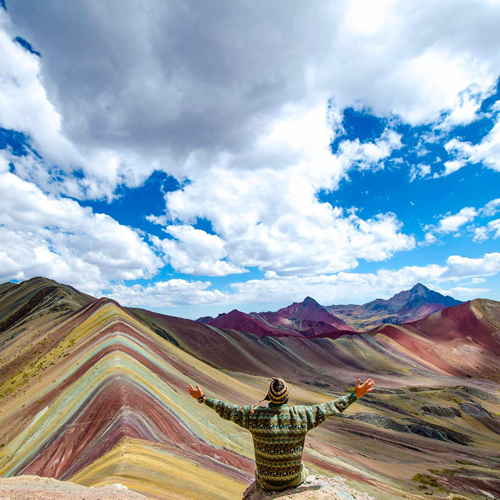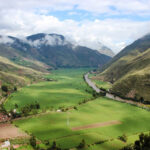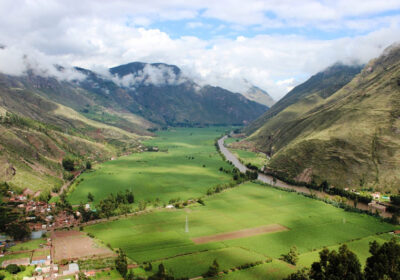Discover the capital of the Inca empire, Cusco
Cusco, the historic capital of the Inca Empire, still has ancient stone walls that reflect its rich heritage. Located in the Huatanay River valley in southeastern Peru, Cusco stands 3,360 meters above sea level and is a significant site filled with monuments, legends, and remnants of the Inca civilization. According to legend, the first Inca, Manco Capac, founded Cusco in the 11th or 12th century. Later, on March 23, 1534, Francisco Pizarro made it a Spanish city.
Table Of Content
- Discover the capital of the Inca empire, Cusco
- Location and Altitude of Cusco
- What means of transportation are available to get to Cusco?
- BY FLIGHTS
- BY BUS
- WHY VISIT CUSCO?
- Cultural reasons
- Weather in Cusco: When to visit?
- What to visit in Cusco?
- Plaza de Armas
- Neighborhood of San Blas
- Qorikancha and the Monastery of Santo Domingo
- Sacsayhuaman is one of the places to visit in Cusco
- Calle Loreto and Piedra de los 12 ángulos
- San Pedro Market
- There are also Tambomachay, Pukapukara, Qenqo and the White Christ
- The Sacred Valley
- Machu Picchu
- Rainbow Mountain
- Maras, Moray and Salt Mines Tour in Cusco Full Day
- South Valley Tour: Tipón – Pikillaqta – Andahuaylillas
- ATV tour through Maras and Moray in the Sacred Valley.
- Tour Waqra Pukara full day
- Palccoyo Rainbow Mountain Tour Full Day
- Full day hike to the seven Ausangate lagoons
- City tour in Cusco Half day
- Tour Laguna Humantay Full Day
Today, Cusco attracts visitors from around the world with its blend of pre-Columbian sites, such as Amaru Cancha and Kiswar Kancha, and colonial architecture, including the Cathedral and the Church of La Merced. Major archaeological sites like Machu Picchu and Saqsaywaman surround the city, along with villages that preserve ancestral traditions.
During the 15th century, under Pachacútec Inca Yupanqui, Cusco experienced significant growth, including the construction of ceremonial plazas and a fortified city layout. The city was designed with four main roads leading to the cardinal points, and it was said to resemble a puma. Different sectors reflected varying levels of social status. The central plazas, which were used for important ceremonies, featured an elevated platform for the Inca king and grand structures like the Sunturwasi.
Location and Altitude of Cusco
Cusco is located in the southeastern highlands of Peru, at an altitude of 3300 metres above sea level. It is located at 13° 30′ 45″ south latitude and 71° 58′ 33″ west longitude. It is connected by road to the cities of Puerto Maldonado, Arequipa, Abancay and Puno.
The capital’s altitude is 3399 masl (Cusco), with a minimum of 532 masl (Pilcopata) and a maximum of 4801 masl (Suyckutambo).
What means of transportation are available to get to Cusco?
BY FLIGHTS
One of the fastest and most convenient ways to get to Cusco is by air. Several airlines operate domestic and international flights.
Domestic flights: Lima, Arequipa and Puerto Maldonado (Latam Airlines and Sky Airlines).
International flights: Bogotá (Colombia), La Paz (Bolivia) and Santiago (Chile).
Flights are usually frequent and there are options to suit all budgets, from economy fares to premium services. Cusco’s Alejandro Velasco Astete International Airport is the region’s main airport and is located a short distance from the city centre.
BY BUS
For those who prefer to enjoy the scenery and have time to travel, buses are a popular and economical option. Several companies (Civa, Oltursa and Cruz del Sur) offer regular services from Lima, Ica, Ayacucho, Arequipa, Puno, Puerto Maldonado, Abancay to Cusco. These buses are usually comfortable and offer different options: from standard seats to reclining seats and first class services. During the journey, there is also the opportunity to make stops to enjoy the sights and discover places of interest.
WHY VISIT CUSCO?
Cusco, Peru is a tourist destination that offers a wide variety of cultural, historical, natural and gastronomic experiences.
Historical reasons
It was the capital of the Inca Empire.
>It is a World Heritage Site and a World Cultural Heritage Site.
>It is the archaeological capital of the Americas.
>It is the epicentre of one of the most advanced pre-Columbian civilisations in the Americas.
Cultural reasons:
It offers a mixture of Inca foundations and colonial constructions.
It has a large number of festivals.
The people of Cusco are famous for their hospitality and friendliness.
Natural reasons:
It is located in a valley surrounded by mountains and valleys.
It has a large number of festivals.
The people of Cusco are famous for their hospitality and friendliness.
Surrounded by mountains and valleys.
It has impressive valleys, rivers, snow-capped mountains, lagoons and forests.
It offers characteristic landscapes of both the highlands and the high jungle.
Gastronomic reasons:
Its gastronomy is a fusion of Andean and Spanish flavours.
It has a large number of restaurants that offer options for all tastes.
These are some of the reasons to visit Machu Picchu.
Cusco is the gateway to the famous citadel of Machu Picchu.
Weather in Cusco: When to visit?
The climate in the city of Cusco is relatively temperate, with cool nights and sunny days. The weather is very changeable: it can go from a sunny day to a torrential downpour in a matter of minutes. Temperatures range from 13°C to 15°C, and this is the case for most of the southern region of Peru.
The dry season in Cusco
The dry season extends from April to October. During these months, the weather is relatively more stable, with sunny days and mild nights. It is the ideal time to visit Cusco if you prefer to avoid the rains and enjoy pleasant temperatures. The dry season attracts many travelers due to its stable climate and is especially popular with those wishing to hike the famous Inca Trail and visit Machu Picchu.
The rainy season in Cusco
The rainy season in Cusco lasts from December to April. During this time, the intensity of the rains can vary, with January and February being the wettest months of the year. Although the weather can be unpredictable, the region has its charm and unique beauty. The landscapes become greener and more lush.
What to visit in Cusco?
Plaza de Armas
The Plaza de Armas is the heart of the historic center of Cusco and one of the essential visits of the city. It was once a swamp that the Incas drained to make it the administrative center of the entire empire, but with the arrival of the Spanish, numerous buildings and churches were built around it, over the Inca temples and palaces.
Today, the plaza is full of tourist restaurants and large chains like McDonald’s or Starbucks, travel agencies and souvenir shops, which has taken away some of the charm of the past, although it is still a must-see place in the city.
Neighborhood of San Blas
Qorikancha and the Monastery of Santo Domingo
The Incas built Qorikancha, a temple dedicated to the sun god. Over time, it was expanded and embellished, eventually becoming the most important religious site in the Inca Empire. One of its most striking features is the use of large, solid stone blocks joined without mortar to form thick walls that were covered with gold leaf. These walls enclosed several temples within the Qorikancha complex, including those dedicated to the sun, moon, and stars.
When the Spanish arrived, they built the Santo Domingo Monastery on top of Qorikancha, destroying the upper part of the Inca temple in the process.
Visiting hours: Monday to Saturday: 8:30 a.m. to 5:30 p.m.; Sunday: 2:00 p.m. to 5:00 p.m.
Sacsayhuaman is one of the places to visit in Cusco
A 40-minute walk north of Cusco’s historic center leads to the 15th-century Sacsayhuaman fortress, built under the rule of the key Inca leader Pachacutec. Though much of it is in ruins, visitors can still admire the impressive stone walls that form three terraces. Inside, visitors will find stairs and stone doors like the Puerta del Sol, as well as images of the Incas on the 400-meter-long walls. If you have extra time, it is recommended that you visit Tambomachay, Pukapukara, and Qenqo before arriving at Sacsayhuaman. To begin, take a taxi from the Plaza de Armas to Sacsayhuaman, then walk to the other sites. The fortress is open from 7:00 to 18:00.
Calle Loreto and Piedra de los 12 ángulos
Loreto Street, located in the historic centre, is the most interesting street in the city, as it is here that the contrast between Inca and colonial architecture is most evident. The Inca walls, located in the lower part of the Spanish buildings, are a true work of art, as the large blocks of stone fit together perfectly like a jigsaw puzzle.
The most famous point of these walls is located a few metres from Loreto Street, on Hatun Rumiyoc Street, where the Stone of the Twelve Angles is located, famous for the perfection of its finish and the twelve angles that surround it.
San Pedro Market
Another place to visit in Cuzco is the San Pedro Market, the oldest and most famous in the city. This market, also known as Mercado Central, was built by the famous Gustave Eiffel, author of the Eiffel Tower. Inside you can see stalls with all kinds of typical products of Peru, such as passion fruit, banana, cassava, Andean potato and others more common in all markets.
It is also a good place to buy handicrafts and try typical local dishes at one of the food stalls.
Visiting hours: Monday to Saturday from 6:30am to 6:30pm. Closed on Sundays at 12 noon.
There are also Tambomachay, Pukapukara, Qenqo and the White Christ
In addition to Sacsayhuaman, there are three other must-see Inca archaeological sites in Cusco. The first is Tambomachay, a site dedicated to the worship of water. Located eight kilometers from Cusco, it is famous for its natural surroundings and hydraulic system with fountains, canals, and aqueducts. Pukapukara, known as the Red Fortress, is a five-minute walk away. There, you can see the ruins of rooms that may have been used as a hunting lodge, guard post, or resting place.
On the way to Sacsayhuaman is Qenqo, a religious complex with remnants of Inca structures, including an amphitheater, astronomical columns, a canal, and an underground chamber. Qenqo is located one kilometer from Sacsayhuaman, near the eight-meter-tall White Christ statue, which offers fantastic views of Cusco. To save money, it is recommended that you purchase the special tourist ticket for the Cusco area, which includes admission to these ruins and other attractions in the city.
The Sacred Valley
The magical Sacred Valley of the Incas, located 15 kilometers from Cusco, is one of the most impressive places to visit in Peru. This Andean valley is home to Inca, indigenous, and colonial archaeological sites, as well as stunning landscapes, and is traversed by several rivers. The Incas valued the valley’s fertile soil and created a terraced system to cultivate maize.
Places to visit in the Sacred Valley include:
Pisac, which is famous for its impressive Inca ruins and craft market. Ollantaytambo, an Inca architectural complex, served various purposes. Moray has circular terraces that the Incas used to experiment with different crops.
The salt mines of Maras consist of many small pools. Chinchero is a beautiful indigenous village with a plaza located on the site of an ancient Inca palace, featuring craft stalls. Day trips from Cusco to Pisac, Ollantaytambo, Moray, and the salt mines usually include a Spanish-speaking guide. For longer trips, you can rent a car or take a taxi. Buying a special tourist ticket for the Sacred Valley can save you money.
Machu Picchu
Located over 100 kilometers from Cusco, Machu Picchu is a famous Inca city and one of the Seven Wonders of the World. Discovered in 1911 by Hiram Bingham, the site features 15th-century ruins, including the Intihuatana Stone and the Temple of the Sun. To fully understand the city’s history, visitors are encouraged to hire a guide.
Due to limited daily access, tickets to visit Machu Picchu or climb Huayna Picchu must be booked months in advance. You can take a train from Cusco or Ollantaytambo to Aguas Calientes, where buses operate hourly to the site. One- and two-day organized tours include tickets, transportation, and a Spanish-speaking guide.
The most enchanting way to reach Machu Picchu is by walking the 40 kilometers of the Inca Trail. This four-day trek offers stunning views and ancient paths. A two-day option is also available. The site is open daily from 6:00 a.m. to 5:30 p.m.
Rainbow Mountain
Another of the best excursions and places to visit in Cusco is the Rainbow Mountain, also known as the Mountain of Seven Colors. Located at over 5,000 meters above sea level in the Andes, it presents one of the most incredible geological phenomena in the world, which has made it one of the most famous places in the area in just a few years.
This explosion of color is the result of a combination of different minerals that make it look from afar like a rainbow has fallen from the sky onto the mountain. Keep in mind that the best time to see the colors clearly is in July and August, the dry season.
The best and most convenient way to get to Rainbow Mountain is to book this excursion from Cusco with a Spanish speaking guide who will take you to one of the most impressive places to visit in Cusco.
Please note that the journey to the starting point of the trek takes approximately three hours. Although the views of the mountain and the trail are impressive, the three hour hike to the Rainbow Viewpoint is quite challenging. It’s recommended to bring warm clothes and coca leaves to prevent altitude sickness.
Although this place is off the beaten track of the usual Sacred Valley tourist trails, it’s becoming very popular and is being visited by more and more people, so if you’re planning to make the trip, it’s worth booking ahead.
For more information, read this article about trekking the Rainbow Mountain.
The best day tours in Cusco
If you already have a Cusco tour package and would like to take advantage of a free day or add a short day trip, there are several activities you can do in Cusco. These full day tours in Cusco will take you to fascinating and lesser known places, allowing you to enjoy experiences different from conventional sightseeing tours both inside and outside the city.
Maras, Moray and Salt Mines Tour in Cusco Full Day
Visit the Maras Salt Mines, where you can take incredible pictures of the landscape and buy the best souvenirs. Then visit the Moray Terraces.
South Valley Tour: Tipón – Pikillaqta – Andahuaylillas
A tour south of Cusco, off the beaten track, with visits to Inca terraces, Wari buildings and the Andahuaylillas Chapel.
ATV tour through Maras and Moray in the Sacred Valley.
Maras and Moray are two tourist destinations located at 3,385 metres above sea level in the northern valley of the Incas. These impressive landscapes offer the opportunity to explore the ancient past of the Inca culture through architecture and history. ATV riding is a fun and exciting way to explore the surrounding area, so this tour is ideal for you: you’ll travel and enjoy the adventure of travelling the rural roads of the Andes, discovering the region’s magnificent nature and colourful fields.
Trips to Maras and Moray are the best option for adventure lovers who want to experience the Andean culture in a fun, unique and safe way.
Tour Waqra Pukara full day
Tourists can now enjoy the Waqrapukara Full Day Tour, a new attraction recently promoted in Cusco. This site is located in the province of Acomayo, near the Apurímac River, at an altitude of 4,300 meters above sea level, south of the city of Cusco. Researchers have not yet deciphered Waqrapukara, which can be considered a fortress, a sanctuary, or an astronomical observatory. It was first built by the Quinchas and later conquered by the Incas. This tour will take you to a different and unusual destination, where you can enjoy the spectacular landscapes, the different lagoons and canyons of the Apurímac Canyon, and also connect with nature and the energy of this amazing place.
Palccoyo Rainbow Mountain Tour Full Day
It’s a unique experience that offers a full day of unforgettable adventure.
During the tour, you’ll enjoy a short and accessible hike, perfect for all fitness levels.
Full day hike to the seven Ausangate lagoons
The day hike to the 7 Ausangate Lagoons is a wonderful experience. You’ll visit the turquoise lagoons, part of the Vilcanota mountain range, and be close to the Ausangate and Ayangate mountains. You’ll enjoy the relaxing hot springs with beautiful views of the mountains and local life.
City tour in Cusco Half day
Discover the charm and culture of Cusco with a guided city tour. Visit the city’s main monuments and historical sites such as the Cathedral, Qoricancha, Sacsayhuaman, Qenqo, Puka Pukara, and Tambomachay.
Tour Qeswachaka y 4 lagunas Full day
Local communities in southern Peru, near the city of Cusco, build the traditional rope bridge Q’eswachaka annually using traditional techniques and materials. As the only surviving Inca bridge in Peru, Q’eswachaka represents an impressive engineering feat worth discovering. Experience this ancient ritual on a full day excursion from Cusco! UNESCO declared it Intangible Cultural Heritage of Humanity in 2013.
Tour Laguna Humantay Full Day
Tour of the Humantay Lagoon, a jewel of the Peruvian Andes.
Begin your adventure by hiking through breathtaking scenery to the lagoon, where the crystal clear waters reflect the majestic mountains.















No Comment! Be the first one.